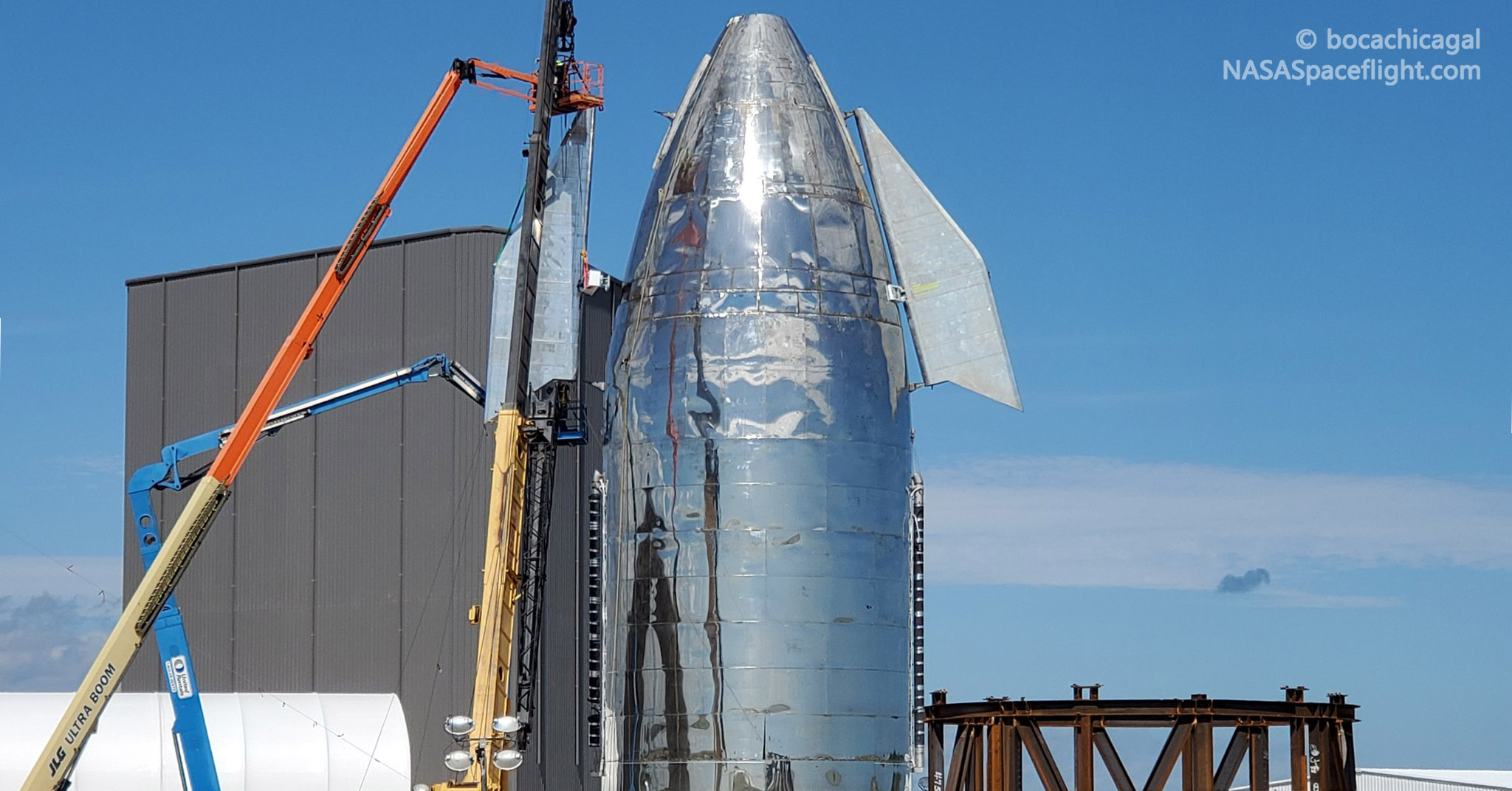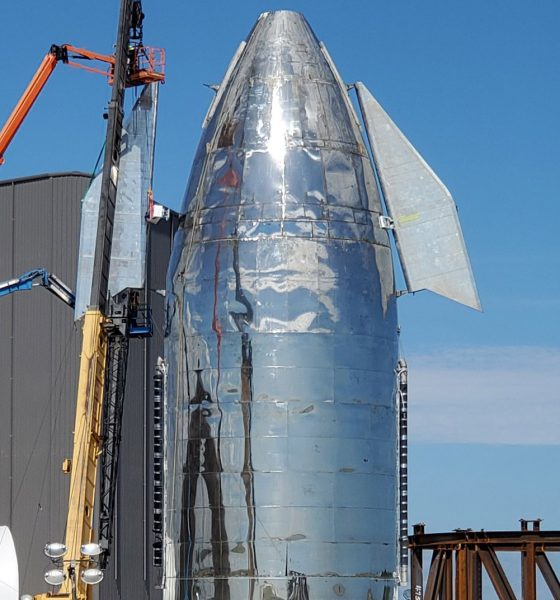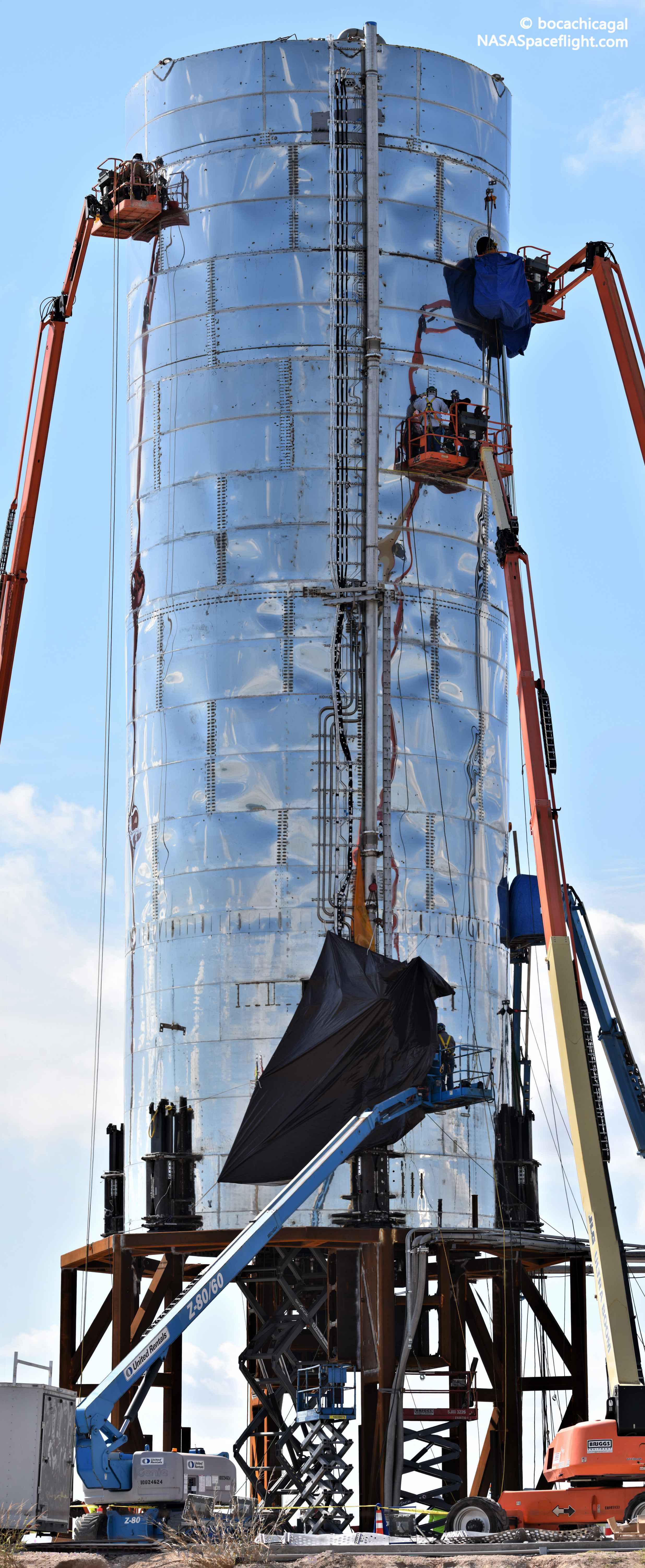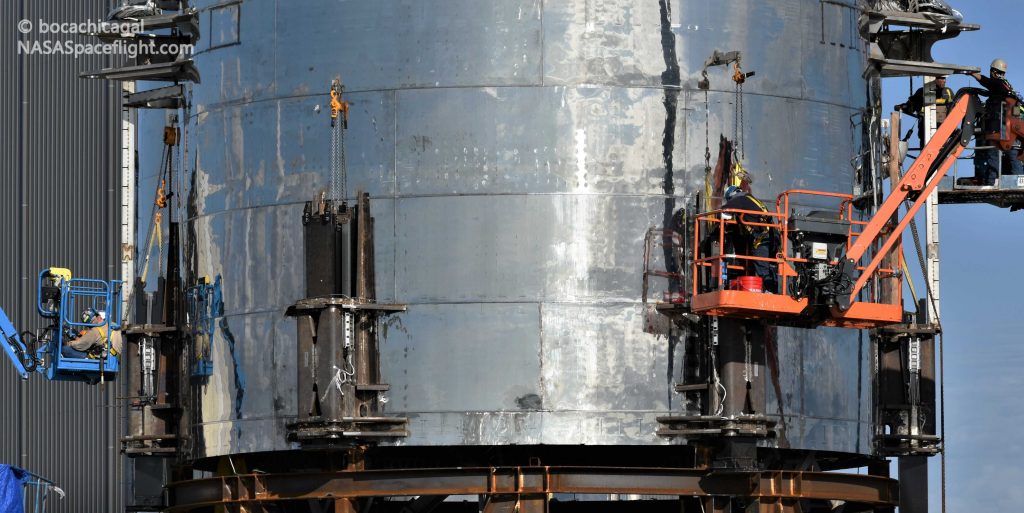

News
SpaceX installs second Starship Mk1 canard ahead of transport to launch pad
SpaceX has begun to install Starship Mk1’s second of two forward ‘canards’, aerodynamic flaps the rocket prototype will soon use to attempt the first radical skydiver-style landing. SpaceX technicians are likely working to fully outfit the rocket before transporting its nose section to the launch pad, where it can be mated to Starship Mk1’s lower tank and engine section.
This second canard installation follows just a few days after SpaceX technicians began installing the first fin, a process that took a fair bit longer than usual as a result of new hardware integrated with the control surfaces this time around. Discussed earlier today, those large mechanism are likely the substantial actuators Starship will need to rapidly tweak its trajectory while falling through the atmosphere.
“Barely three weeks after the rocket’s forward flaps (canards) were removed, SpaceX technicians began the reinstallation process with one major visible difference: a massive motorcycle-sized actuator. The appearance of that previously unseen actuator mechanism on the first reinstalled canard suggests that this time around, SpaceX is installing Starship’s flaps with their final purpose of controlling Starship’s free-fall in mind.”
Teslarati, 11/04/2019
With the first installation complete, SpaceX’s Boca Chica technicians will likely be able to install Starship Mk1’s second canard more quickly. Beyond attaching the prototype’s control surfaces, SpaceX has also made a significant amount of progress outfitting Starship Mk1’s nose section with other hardware, notably fitting the nose’s exterior fuel lines with what is likely insulation.
That same black and silver insulation has been visible on SpaceX’s Starship Mk2 prototype in Cocoa, Florida, where technicians appear to have taken a slightly different step than Texas, insulating the plumbing before installing it on the vehicle.
Together again, at last
On October 30th, SpaceX lifted Starship Mk1’s tank and engine section onto a remote-controlled transported and moved the rocket half approximately a mile to its Boca Chica, Texas launch facilities, where Starship was installed on a freshly-constructed launch mount. SpaceX’s decision to move Mk1’s halves separately came as a bit of a surprise but appears to have been driven by a need to ensure that the spacecraft’s bottom half fit properly on the launch mount’s umbilical connections. Between the mount’s hefty steel beams, the beginnings of those panels (often deemed ‘quick disconnects’) are visible at the base of the panorama below.

Also visible around the base of Starship Mk1’s shiny aft section are a number of black steel structures – six, to be precise. Those protrusions are Starship’s landing legs, one of the last significant mechanisms installed on the rocket before SpaceX transported the half to the launch site. For unknown reasons, Starship Mk1’s legs – as well as Mk2’s – are almost nothing like those SpaceX have proposed for past Starship iterations and are even more dissimilar to Falcon 9’s extensively flight-proven hardware.

Instead of Falcon 9’s triangular, spread-eagle legs or BFR’s older tripod fin setup, Starship 2019 features six peg-like legs that only deploy or retract directly up or down. As some observers have noted, some of the hardware installed in and around those steel beam-like legs resembles industrial-grade linear brakes, suggesting that the legs will be deployed from their stowed positions by releasing those brakes and letting gravity do most of the work.
Layman concerns remain about the stability of six perfectly vertical legs with a span essentially the same as Starship’s own diameter, a possible indicator that the dead-simple landing legs on Mk1 and Mk2 may be dramatically simplified for the sake of speedy development. At the same time, it’s possible that their linear brake mechanisms could simultaneously offer some sort of minor suspension or terrain compensation, but their extremely narrow span fundamentally limits their potential stability. For landing on a prepared concrete slab, however, they will likely be sufficient, although almost any lateral velocity at all could result in Starship tipping over.
For now, SpaceX has road closures scheduled on November 7th, 8th, and 12th, the former two of which are probably more focused on transporting Starship Mk1’s nose section to the pad for installation atop the tank section. At the same time, SpaceX is clearly preparing for a series of major Starship tests, including a tank proof test, a wet dress rehearsal, and a triple-Raptor static fire. Stay tuned for updates!
Check out Teslarati’s Marketplace! We offer Tesla accessories, including for the Tesla Cybertruck and Tesla Model 3.

News
Tesla FSD fleet is nearing 7 billion total miles, including 2.5 billion city miles
As can be seen on Tesla’s official FSD webpage, vehicles equipped with the system have now navigated over 6.99 billion miles.

Tesla’s Full Self-Driving (Supervised) fleet is closing in on almost 7 billion total miles driven, as per data posted by the company on its official FSD webpage.
These figures hint at the massive scale of data fueling Tesla’s rapid FSD improvements, which have been quite notable as of late.
FSD mileage milestones
As can be seen on Tesla’s official FSD webpage, vehicles equipped with the system have now navigated over 6.99 billion miles. Tesla owner and avid FSD tester Whole Mars Catalog also shared a screenshot indicating that from the nearly 7 billion miles traveled by the FSD fleet, more than 2.5 billion miles were driven inside cities.
City miles are particularly valuable for complex urban scenarios like unprotected turns, pedestrian interactions, and traffic lights. This is also the difference-maker for FSD, as only complex solutions, such as Waymo’s self-driving taxis, operate similarly on inner-city streets. And even then, incidents such as the San Francisco blackouts have proven challenging for sensor-rich vehicles like Waymos.
Tesla’s data edge
Tesla has a number of advantages in the autonomous vehicle sector, one of which is the size of its fleet and the number of vehicles training FSD on real-world roads. Tesla’s nearly 7 billion FSD miles then allow the company to roll out updates that make its vehicles behave like they are being driven by experienced drivers, even if they are operating on their own.
So notable are Tesla’s improvements to FSD that NVIDIA Director of Robotics Jim Fan, after experiencing FSD v14, noted that the system is the first AI that passes what he described as a “Physical Turing Test.”
“Despite knowing exactly how robot learning works, I still find it magical watching the steering wheel turn by itself. First it feels surreal, next it becomes routine. Then, like the smartphone, taking it away actively hurts. This is how humanity gets rewired and glued to god-like technologies,” Fan wrote in a post on X.
News
Tesla starts showing how FSD will change lives in Europe
Local officials tested the system on narrow country roads and were impressed by FSD’s smooth, human-like driving, with some calling the service a game-changer for everyday life in areas that are far from urban centers.

Tesla has launched Europe’s first public shuttle service using Full Self-Driving (Supervised) in the rural Eifelkreis Bitburg-Prüm region of Germany, demonstrating how the technology can restore independence and mobility for people who struggle with limited transport options.
Local officials tested the system on narrow country roads and were impressed by FSD’s smooth, human-like driving, with some calling the service a game-changer for everyday life in areas that are far from urban centers.
Officials see real impact on rural residents
Arzfeld Mayor Johannes Kuhl and District Administrator Andreas Kruppert personally tested the Tesla shuttle service. This allowed them to see just how well FSD navigated winding lanes and rural roads confidently. Kruppert said, “Autonomous driving sounds like science fiction to many, but we simply see here that it works totally well in rural regions too.” Kuhl, for his part, also noted that FSD “feels like a very experienced driver.”
The pilot complements the area’s “Citizen Bus” program, which provides on-demand rides for elderly residents who can no longer drive themselves. Tesla Europe shared a video of a demonstration of the service, highlighting how FSD gives people their freedom back, even in places where public transport is not as prevalent.
What the Ministry for Economic Affairs and Transport says
Rhineland-Palatinate’s Minister Daniela Schmitt supported the project, praising the collaboration that made this “first of its kind in Europe” possible. As per the ministry, the rural rollout for the service shows FSD’s potential beyond major cities, and it delivers tangible benefits like grocery runs, doctor visits, and social connections for isolated residents.
“Reliable and flexible mobility is especially vital in rural areas. With the launch of a shuttle service using self-driving vehicles (FSD supervised) by Tesla in the Eifelkreis Bitburg-Prüm, an innovative pilot project is now getting underway that complements local community bus services. It is the first project of its kind in Europe.
“The result is a real gain for rural mobility: greater accessibility, more flexibility and tangible benefits for everyday life. A strong signal for innovation, cooperation and future-oriented mobility beyond urban centers,” the ministry wrote in a LinkedIn post.
News
Tesla China quietly posts Robotaxi-related job listing
Tesla China is currently seeking a Low Voltage Electrical Engineer to work on circuit board design for the company’s autonomous vehicles.

Tesla has posted a new job listing in Shanghai explicitly tied to its Robotaxi program, fueling speculation that the company is preparing to launch its dedicated autonomous ride-hailing service in China.
As noted in the listing, Tesla China is currently seeking a Low Voltage Electrical Engineer to work on circuit board design for the company’s autonomous vehicles.
Robotaxi-specific role
The listing, which was shared on social media platform X by industry watcher @tslaming, suggested that Tesla China is looking to fill the role urgently. The job listing itself specifically mentions that the person hired for the role will be working on the Low Voltage Hardware team, which would design the circuit boards that would serve as the nervous system of the Robotaxi.
Key tasks for the role, as indicated in the job listing, include collaboration with PCB layout, firmware, mechanical, program management, and validation teams, among other responsibilities. The role is based in Shanghai.
China Robotaxi launch
China represents a massive potential market for robotaxis, with its dense urban centers and supportive policies in select cities. Tesla has limited permission to roll out FSD in the country, though despite this, its vehicles have been hailed as among the best in the market when it comes to autonomous features. So far, at least, it appears that China supports Tesla’s FSD and Robotaxi rollout.
This was hinted at in November, when Tesla brought the Cybercab to the 8th China International Import Expo (CIIE) in Shanghai, marking the first time that the autonomous two-seater was brought to the Asia-Pacific region. The vehicle, despite not having a release date in China, received a significant amount of interest among the event’s attendees.








